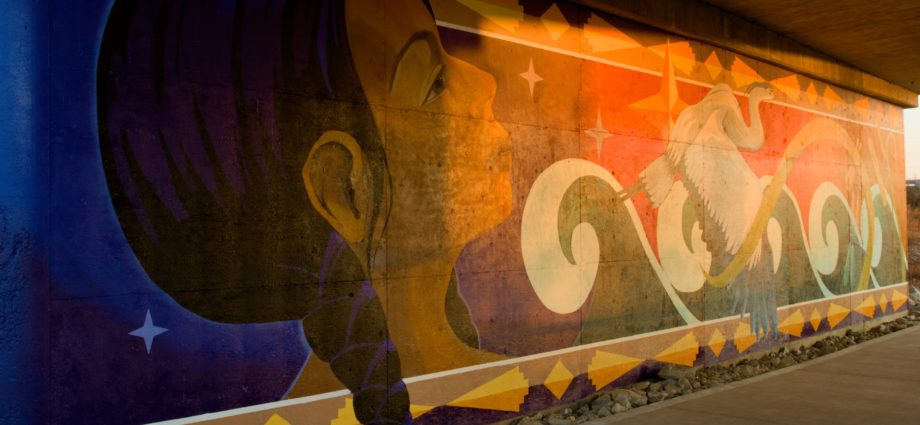Just south of Lawrence, Kansas is one of the most prolific exhibitions of wildlife in the area. Despite rampant urbanization—further intensified by the South Lawrence Trafficway (SLT)—the Haskell and Baker Wetlands have been a mainstay for numerous wildlife, including migratory birds/butterflies, frogs, and native vegetation.
A recent unveiling of a mural on the underpass of 31st St. provides a much needed embellishment to a walking path while also paying homage to the land and people that are tied to it.
As part of an effort between the Douglas County Commission and VanGo Inc., the initial motive for a mural was to deter graffiti. Rick Wright, the Art Director of VanGo, wanted to capture the essence of the nearby wetlands and historical Indigenous people of the area—including the history of Haskell Indian Nations University (HINU), which started out as a boarding school for Indigenous youth in 1884.
Although there have been negative connotations with the SLT and the historic treatment of Indigenous people, Wright emphasized the mural was never meant to dwell on the negativity but rather meant to exude a message of positivity; a vibrant reminder that environmental and Indigenous issues have hope in the future, despite the historic setbacks.
After three weeks of painting from VanGo youth, the unveiling with the county occurred on November 2, 2020.
VanGo, Inc.—an arts-based social service and after-school/summer job-training program for high-needs and under-served youth aged 14-24—employed 12 young adults for the mural. Although Wright was instrumental in the design and overall implementation, the youth workers were the ones who put in the hours to paint the underpass over a three-week period. VanGo has also been involved in many other mural projects around Lawrence commissioned by various local businesses and organizations, including the Lawrence Memorial Hospital, Natural Grocers, and the Lawrence Public Library. The goals for the youth who participate in the program are to instill overall life-skills, self-expression, and self-confidence through holistic job-training.

In an effort to inform the youth on the intent of the underpass mural project, Wright collaborated with local artist Mona Cliff and her husband, HINU professor Jimmy Beason, on the design and history of Indigenous people.
Although the youth worked on the designs of past murals, social distancing parameters caused Wright and Cliff to collaboratively streamline the design. One of Cliff’s contributions was the ribbon design above and below the mural that pays homage to the ribbon work of the Wazhazhe (Osage; the former being an endonym) Nation.
The Wazhazhe were one of the tribes that historically inhabited the land around Lawrence. Professor Beason—an enrolled member of the Wazhazhe Nation—gave a presentation to the youth on this historical context, along with the history of HINU.
Beason and Cliff expressed gratitude for being a part of the process, with Cliff saying, “It was a pleasure to work with Rick and I look forward to working with VanGo on other projects.” She is glad how people are “…turning a corner to include more Indigenous voices and bringing visibility to the Indigenous community, [especially since] we’re a huge part of history here, not to mention the people who lived here before the [founding of Lawrence].”
When asked about future projects, she mentioned the desire for increased occurrence of community-based art projects, especially murals, to represent the Indigenous community. “There is a lot of open space for murals here…but one of the main obstacles to starting these projects is funding.” Further inquiry reveals collaboration as an effective remedy to help alleviate that impediment, as she mentioned a future mural project with Tulsa-based artist Yatika Fields on a wall behind Lawrence Antique Mall.
Another possible avenue she brought up is working with HINU. She is very appreciative of the effort by Carrie Cornelius, Haskell librarian, in bringing Indigenous artists such as Steven Grounds and Steven Paul Judd to the university. She was excited at the idea for community-based projects there and would be willing to initiate that, given the opportunity.
She also mentioned the Indigenous Arts Initiative—created by the Kansas Creative Arts Industry Commission—as an avenue for a larger Indigenous arts programming. They have brought in Indigenous artists of varying mediums to conduct workshops. One of the most recent workshops involved traditional quillwork led by Dana Warrington of the Menominee and Potawatomi tribes. According to the website, the next workshop will be a virtual event as an adaption to COVID-19 social distancing guidelines.
Despite being in the middle of a pandemic, the underpass mural project sheds light on the possibility of bringing projects like these to fruition. Wright mentioned how social-distancing guidelines were utilized for the mural by using facemasks and rotating shifts.
So, the possibility of creating more art in the near future is exciting. Especially for Cliff, who has many ideas and sees the positive ramifications of them. “Hopefully, I can find more funding…I see all of these walls now and envision a mural there.”
Wright also expressed interest in working with Cliff and/or Indigneous groups again. “I feel like the youth learned so much [about Indigenous history] with this project. We would certainly welcome other opportunities to learn or to be involved in another project.”
On the walking path, there are two other underpasses owned by the state. When asked about painting those areas, Wright explained that it would need to be commissioned by a whole other governmental agency. Given the opportunity though, he would be eager: “…we would be interested in doing another project or even advocating for other artists to [paint the other underpasses] as well. It would be equally as impressive to have additional artists collaborate to expand the area.”

Photography by Zachary Arquette

